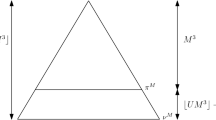Abstract
Every birth and death chain on a finite tree can be represented as a random walk on the underlying tree endowed with appropriate conductances. We provide an algorithm that finds these conductances in linear time. Then, using the electric network approach, we find the values for the stationary distribution and for the expected hitting times between any two vertices in the tree. We show that our algorithms improve classical procedures: they do not exhibit ill-posedness and the orders of their complexities are smaller than those of traditional algorithms found in the literature.
Similar content being viewed by others
References
Bertoncini O (2011) Cut-off and escape behavior for birth and death chains on trees. Lat A J Probab Math Stat Phys 8:149–162
Davis TA (2006) Direct methods for sparse linear systems, Siam book series on the fundamentals of algorithms, SIAM, Philadelphia
Dongarra J (2000) Sparse matrix storage formats. In: Bai Z, Demmel J, Dongarra J, Ruhe A, van der Vorst H (eds) Templates for the solution of algebraic eigenvalue problems: a practical guide. SIAM, Philadelphia
Doyle PG, Snell JL (1984) Random walks and electrical networks. The Mathematical Association of America, Washington DC
Fayolle G, Krikun M, Lasgouttes JM (2004) Birth and death processes on certain random trees: classification and stationary laws. Probab Theory Relat Fields 128:386–418
Grinstead CM, Snell JL (1997) Introduction to probability, second edition, American Mathematical Society. Providence RI
Kelly FP (1979) Reversibility and stochastic networks. Wiley, Chichester
Ma Y (2010) Birth-death processes on trees. Sci China Math 53:1–10
Palacios JL, Tetali P (1996) A note on expected hitting times for birth and death chains. Stat Probab Lett 30:119–125
Palacios JL (2009) On hitting times of random walks on trees. Stat Probab Lett 79:234–236
Quiroz AJ (1989) Fast random generation of binary, t-ary and other types of trees. J Class 6:223–231
Tarry G (1895) Le problème des labyrinthes. Nouvelles Annales de Mathématiques, ser 3(14):187–190
Author information
Authors and Affiliations
Corresponding author
Rights and permissions
About this article
Cite this article
Palacios, J.L., Quiroz, D. Birth and Death Chains on Finite Trees: Computing their Stationary Distribution and Hitting Times. Methodol Comput Appl Probab 18, 487–498 (2016). https://doi.org/10.1007/s11009-014-9436-1
Received:
Revised:
Accepted:
Published:
Issue Date:
DOI: https://doi.org/10.1007/s11009-014-9436-1



